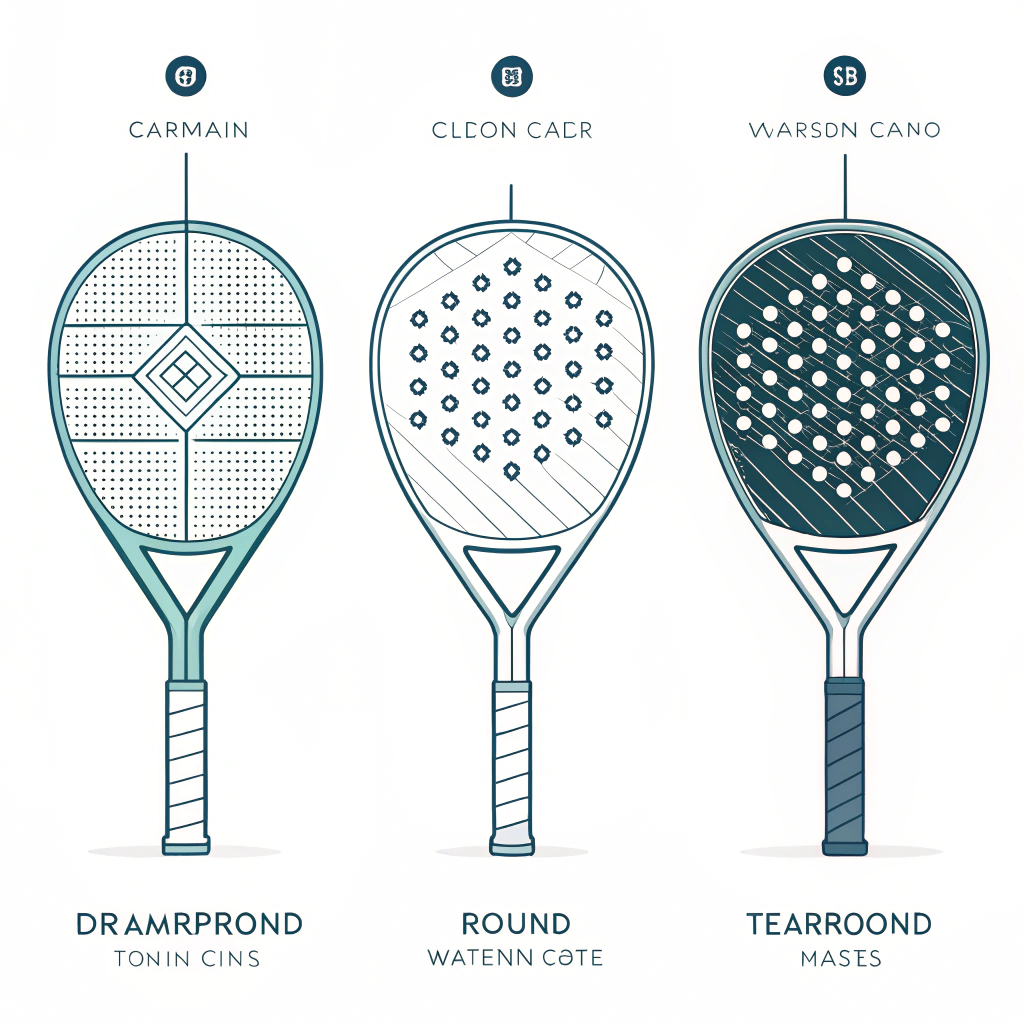Fast Answer: Lightweight padel rackets combine advanced materials such as carbon fiber1 with innovative design to boost speed and agility. By evaluating design types—Diamond, Round, and Teardrop—and their manufacturing techniques, procurement managers can tailor solutions that enhance performance and meet customer expectations.
In today's competitive padel market, the importance of lightweight rackets goes beyond reducing weight. They contribute significantly to a player's speed, agility, and overall performance on the court. For B2B buyers looking to upgrade their product lines or develop new designs, understanding the technical differences and performance metrics is essential.
Modern players demand equipment that offers the perfect balance between power and control. Lightweight rackets allow faster swing speeds, reduced arm fatigue, and improved maneuverability. These factors translate into better on-court performance and increased competitive edge in tournaments and club play.
Procurement managers2 and product developers should consider the following technical aspects when comparing lightweight padel rackets:
-
Material Composition:
High-performance rackets utilize various forms of carbon fiber—ranging from 3k to 12k or even 18k—to enhance stiffness without adding extra weight. The selection of fiber type directly influences the racket's durability, flexibility, and performance under pressure. -
Design Variants:
The three main designs are Diamond, Round, and Teardrop shapes. Each design presents unique characteristics:- Diamond: Optimized for power and aggressive play.
- Round: Focused on control and ease of handling.
- Teardrop: Offers a balanced mix, accommodating both power and precision.
-
Manufacturing Techniques:
Advanced production methods ensure precision and consistency in each racket. Rapid prototyping3 (打样快速) and timely delivery underline effective supply chain management4. Integrated quality checks improve reliability and adherence to performance specifications. -
Customization Options:
Custom padel rackets allow brands to differentiate through tailored designs, printing, and logo imprints. This flexibility is crucial for building competitive branding strategies in the B2B space. -
Performance Metrics:
Key metrics include weight, balance, and stiffness rating. A lighter racket can enhance swing speed, yet maintaining stability through precise design and material selection is equally important.
When deciding between various padel racket designs, detailed comparisons provide clarity. The table below offers a summarised overview of the critical features and benefits associated with each design:
| Feature | Diamond Design | Round Design | Teardrop Design |
|---|---|---|---|
| Main Focus | Power and aggressive play | Control and maneuverability | Balance between power & precision |
| Weight Distribution | Heavier in the head for power | Evenly distributed for consistent swing | Slight head-heaviness for optimal balance |
| Player Type Preference | Experienced players seeking offensive play | Beginners and control-oriented players | Intermediate players wanting versatility |
| Material Flexibility | Uses high-grade carbon fiber for stiffness | May use composite mixes for enhanced grip | Blends rigidity with elasticity |
| Customization | Supports custom shapes and prints | Opens up versatile printing options | Offers multiple design customizations |
| Application | Match play in high-intensity situations | Club-level practice and training | Competitive play with both defensive & offensive strategies |
This table provides an at-a-glance insight into how each design can meet different market needs. For companies seeking to tailor their products to specific user profiles, understanding these nuances is key to making informed procurement decisions.
Modern padel rackets are a product of cutting-edge manufacturing techniques that integrate advanced materials and innovative design processes. The use of carbon fiber—available in different configurations such as 3k, 12k, and 18k—enables manufacturers to fine-tune a racket's weight, stiffness, and durability according to desired specifications.
-
Material Selection:
Carbon fiber variants provide both strength and lightweight attributes. For example, an 18k carbon fiber layer might offer superior stiffness ideal for aggressive play, while a 3k fiber provides flexibility suitable for control-oriented designs. -
Manufacturing Process:
NEX Padel leverages advanced techniques that ensure precision. Our rapid prototyping3 allows for quick adjustments before final production, ensuring that every version of the racket meets strict quality controls. This approach reduces lead times and enhances production reliability. -
Customization and Flexibility:
The ability to customise shapes and add personalized elements such as racket color and hand grip logo further aligns with market demands. Our production line adapts quickly to design alterations, ensuring that custom orders meet individual client requirements without compromising on quality. -
Testing and Quality Assurance5:
Rigorous performance testing in controlled environments validates both the durability and on-court performance of every racket design. This data-driven approach assures buyers that the products are dependable, helping them make informed decisions.
For procurement managers in the sporting goods sector, the process of selecting the right padel racket involves several best practices:
-
Conduct Detailed Specifications Analysis:
Evaluate weight, balance, and design parameters based on the playing profile you intend to target. Data comparisons such as the table above can streamline initial selection. -
Engage with Manufacturers Directly:
A trusted manufacturer like NEX Padel offers transparent production methods, quality assurance data, and flexible customization capabilities. Direct communication can help tailor products to precise market needs. -
Consider Long-Term Performance Data:
Look for client testimonials, case studies, and technical performance reports. Companies that conduct thorough testing and provide detailed performance metrics can build greater trust with their B2B partners. -
Review Customization Capabilities:
In today’s branded world, tailor-made padel rackets with specific colors, prints, and logos can add value for clubs and sports retailers. Prioritize manufacturers that offer this flexibility without extended timelines. -
Ensure Supply Chain Reliability:
Quick sampling and timely delivery are critical. Evaluate the manufacturer’s ability to meet deadlines consistently, ensuring that your inventory remains robust and responsive to market changes.
Table below highlights the procurement decision factors along with recommended actions:
| Procurement Factor | Key Consideration | Recommended Action |
|---|---|---|
| Technical Specifications | Weight, balance, material properties | Compare data sheets and conduct side-by-side analysis |
| Manufacturer Transparency | Production techniques, quality control, customization ability | Engage directly to discuss specific production needs |
| Customization Options | Ability to adapt shapes, prints, and components | Request samples and prototypes for evaluation |
| Lead Times | Market demand and production turnaround | Assess manufacturer’s historical performance data |
| Post-Procurement Support | After-sales service, warranty, and training support | Review support policies and client testimonials |
By following these best practices, procurement managers can confidently select padel rackets that align with their business goals and elevate product performance.
In summary, lightweight padel rackets offer a significant competitive advantage when built with advanced materials and thoughtfully engineered designs. By comparing key features of Diamond, Round, and Teardrop shapes, buyers can align equipment choices with customer performance preferences. The integration of carbon fiber technologies, fast turnaround production methods, and the potential for full customization sets up a versatile portfolio perfect for any sporting goods inventory.
For businesses in the sports equipment industry, choosing the right padel racket is more than a material acquisition—it's an investment in performance enhancement, brand differentiation, and long-term customer satisfaction. Evaluating detailed technical data, engaging with experienced manufacturers like NEX Padel, and applying a robust decision-making framework will ensure that each procurement decision drives market success.
We encourage you to analyze your market requirements and engage in discussions with knowledgeable manufacturers. The balance between technical performance, customization, and durability emerges as the key factor in establishing a winning padel equipment line.
People Also Ask
-
Why is a lightweight padel racket important for performance?
Lightweight padel rackets enhance agility and speed while reducing fatigue, allowing players to react quickly during fast-paced matches. -
How does carbon fiber improve padel racket durability and performance?
Carbon fiber provides high strength-to-weight ratios, improving racket stiffness and resilience. Different grades (3k, 12k, 18k) offer varied performance characteristics to suit diverse playing styles. -
What are the benefits of custom padel rackets compared to standard designs?
Custom padel rackets offer tailored weight distribution, personalized design elements, and branding options, which can better meet specific player needs and enhance market differentiation.
-
carbon fiber: Learn about the advanced composite material known for its high strength-to-weight ratio. This article explains its properties, variants (like 3k, 12k, and 18k), and applications in sports equipment manufacturing. ↩ ↩
-
Procurement managers: Discover the strategic role of procurement managers in sourcing quality products and negotiating favorable terms in B2B environments. This resource details their responsibilities and best practices. ↩ ↩
-
Rapid prototyping: Explore how rapid prototyping accelerates the design iteration process, enabling manufacturers to quickly test and refine products. Learn about its benefits in reducing lead times and production costs. ↩ ↩ ↩2
-
Supply chain management: Understand the strategies behind effective supply chain management that optimize logistics, production, and delivery processes. This explanation covers methods to enhance efficiency and responsiveness. ↩ ↩
-
Quality Assurance: Gain insights into quality assurance practices that ensure product reliability and customer satisfaction. This link provides an overview of testing protocols and quality control measures in manufacturing. ↩ ↩







